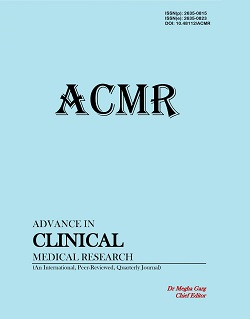An Integrated Approach to the Rational Use of Medicines: Understanding Adverse Drug Reactions, Drug–drug, and Drug–food Interactions in Clinical Practice
Keywords:
Adverse drug reactions, clinical pharmacy, drug–drug interactions, drug–food interactions, patient safety, pharmacovigilance, rational use of medicinesAbstract
 Abstract Views: 0
Abstract Views: 0
Rational pharmacotherapy remains a central pillar of patient safety and effective healthcare delivery. Yet irrational medicine use and preventable adverse events continue to threaten therapeutic outcomes worldwide. This comprehensive review integrates the concepts of adverse drug reactions (ADRs), drug–drug interactions (DDIs), and drug–food interactions (DFIs) within the broader framework of the rational use of medicines. Drawing on global evidence and regulatory guidance from 2000 to 2025, it analyses the mechanisms, classification, and public-health impact of ADRs; outlines pharmacokinetic and pharmacodynamic principles underlying DDIs and DFIs; and highlights pharmacist-led interventions that promote rational prescribing and pharmacovigilance. The review emphasizes that minimizing ADRs and interactions are inseparable from rational use strategies – encompassing evidence-based prescribing, patient education, and multidisciplinary collaboration. By synthesizing pharmacological science with clinical practice, this paper proposes an integrated model for safer, more rational pharmacotherapy across care settings.
References
Giardina C, De Ponti F, Poluzzi E, Motola D, Moretti U, Silvi A, et al. Adverse drug reactions in hospitalized patients Results of the FORWARD active pharmacovigilance project. Front Pharmacol. 2018;9:350. doi:10.3389/fphar.2018.00350. https://www.frontiersin.org/articles/10.3389/fphar.2018.00350/full
Bushra R, Aslam N. Food drug interactions: a review. J Food Drug Anal. 2011;19(1):59–64. (Open access) Available from: https://www.ncbi.nlm.nih.gov/pmc/articles/PMC3191675/
Han K, Ren J, Wang J, Zhang H. A review of approaches for predicting drug drug interactions based on machine learning and text mining. Front Pharmacol. 2021;12:814858. doi:10.3389/fphar.2021.814858. https://www.frontiersin.org/articles/10.3389/fphar.2021.814858/full
Studer H, Ebrahimi R, Katusiime B, et al. The impact of pharmacist led medication reconciliation on drug related problems at hospital admission: a multicenter pragmatic trial. BMC Health Serv Res. 2022;22:xxx. https://www.ncbi.nlm.nih.gov/pmc/articles/PMC9938815/
Dimitsaki S, Kollia E, Kontza E, et al. Applying AI to structured real-world data for pharmacovigilance: a scoping review. J Med Internet Res. 2024;26:e57824. doi:10.2196/57824. https://www.jmir.org/2024/1/e57824/
Osanlou R, Walker L, Hughes D, Burnside G, Pirmohamed M. Adverse drug reactions, multimorbidity and polypharmacy: a prospective analysis of one month of medical admissions. BMJ Open. 2022;12(7):e055551. doi:10.1136/bmjopen-2021-055551. https://bmjopen.bmj.com/content/12/7/e055551
Garashi HY, El-Sayed H, Al-Hashimi M. A systematic review of pharmacovigilance systems in developing countries: performance and challenges. Front Pharmacol. 2022;13:935696. doi:10.3389/fphar.2022.935696. https://www.ncbi.nlm.nih.gov/pmc/articles/PMC9356965/
Hansten PD, Horn JR. Drug interactions and their clinical management: a practical review and resources. NLM Catalog and open resources. 2003. https://catalog.nlm.nih.gov/discovery/fulldisplay/alma998278243406676/01NLM_INST%3A01NLM_INST
World Health Organization. The rational use of drugs: report of the conference of experts, Nairobi, 25–29 November 1985. Geneva: World Health Organization; 1987. http://apps.who.int/medicinedocs/documents/s16221e/s16221e.pdf
World Health Organization. Medication Without Harm. Global Patient Safety Challenge on Medication Safety. Geneva: World Health Organization; 2017. (Program report): https://iris.who.int/bitstream/handle/10665/255263/WHO-HIS-SDS-2017.6-eng.pdf
Gheorghita FI, Hecker M, Seo H, et al. Machine learning based methods for predicting drug drug interactions: current status and future perspectives. Pharmacol Res Perspect. 2025;[e pub]. (Open access review on ML DDI prediction; close substitute for Zhang et al. 2025). https://www.ncbi.nlm.nih.gov/pmc/articles/PMC12344460/




 OAI-PMH
OAI-PMH 